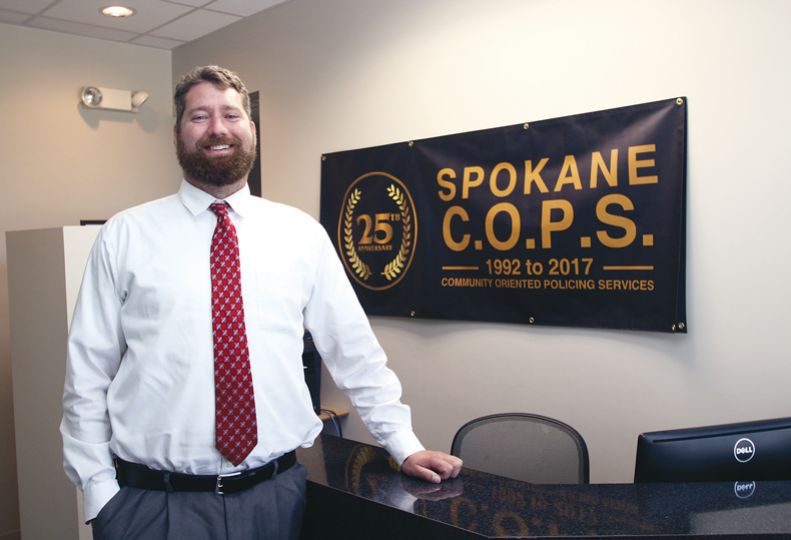
Home » Spokane COPS looks to balance future with effective past
Spokane COPS looks to balance future with effective past
Ex-police chief introduced community-oriented policing

July 20, 2017
Patrick Striker, executive director of Spokane Community Oriented Policing, known here more generally as Spokane COPS, says a challenge he sees facing the 25-year-old nonprofit—and others like it—is balancing its past successes with more recent and emerging technologies.
“The question is, ‘How do you take that ’80s model of community-oriented policing and make it more contemporary in a digital age without losing the things that the ’80s model used to be successful’” Striker says.
Community-oriented policing involves citizen volunteers working in tandem with law enforcement, specifically in areas such as reporting crime and providing neighborhood surveillance. Trained volunteers are taught to report while leaving the apprehension of criminals to commissioned officers.
Striker, who has been the executive director of the 501(c)3 for two years, has a part-time digital coordinator on staff. During Striker’s brief tenure, COPS redesigned its website and established social media channels via Facebook, Pinterest, and Twitter.
“It’s been a great way to promote the organization and recruit more volunteers,” he says. “But that digital interaction can be shallower. There will never be a substitute for getting to know your neighborhood in a more intimate fashion.”
COPS began in 1992, five years after former Spokane Police Chief Terry Mangan took the top cop job here. Mangan held the position from 1987 to 1998 and was known for his introduction of community-oriented policing here and the creation of the 11 neighborhood COPS offices across Spokane.
Mangan left Spokane for a job as a consultant at the FBI Academy in Quantico, Va. He died in 2014 at the age of 76.
Spokane COPS has an average annual budget of $400,000, which is funded mostly by the Spokane Police Department.
An 11-member board of directors oversees COPS operations and meets regularly with Spokane Police Department officials to determine whether or not volunteers are meeting the needs of law enforcement and the community, Striker says.
“In order for us to be successful, we need all the community feedback we can get,” he says. “It’s a service we provide to the community. We need to know, ‘Is this making a difference?’’’
Including Striker, COPS has a staff of six employees, two of whom are part time. Also, through funding from a state grant, a crime victims’ advocate shares office space with COPS staff at 6107 N. Astor, on Spokane’s North Side.
Striker says the nonprofit today relies on 300 volunteers contributing an annual average of 30,000 hours of community-policing service to the Spokane community.
The 11 neighborhood locations are at 2116 E. First, 169 S. Stevens, 802 E. Sharp, 2809 E. 29th, 1901 W. Boone, 4141 N. Regal, 4705 N. Addison, 630 W. Shannon, 5124 N. Market, and 2215 W. Wellesley. Each station is staffed by a commissioned Spokane police officer.
A COPS mobile unit is assigned to the North Hill neighborhood, which is bordered by Francis Avenue to the north, Ash Street to the west, Division Street to the east, and Cora and Courtland avenues to the south, along a bluff overlooking Spokane.
The Spokane County Sheriff’s Office operates the separate Sheriff Community Oriented Policing Effort, or SCOPE, which was founded two years after Spokane COPS was formed, Striker says.
Volunteers can help assist police in tasks ranging from providing staffing hours at their neighborhood COPS office and performing neighborhood property inspections to filing reports involving suspicious activities, he says.
COPS volunteers must be at least 18 years old and complete a 12-hour, new volunteer orientation. An application must be submitted, and volunteers have to agree to a background check, he says.
Spokane Police Capt. Dan Torok, a 28-year veteran of the police force here, says he’s seeing a renewed interest in community volunteerism with Spokane COPS.
“When it first started, it was heavy with volunteers. But as the years have progressed, we’ve seen those numbers taper off,” Torok says. “In the last few years, though, it appears as though people are getting interested in serving again.”
Torok says it’s absolutely critical for communities to have on-going relationships with law enforcement agencies.
“Here’s an example. We may see the numbers and observe that burglaries are up in your neighborhood,” Torok says. “But then we’ll get out to your neighborhood and start talking to you and your neighbors about statistics and discover that what you all are most concerned about is chronic speeding in your neighborhood.”
“So when we have the eyes and ears of the (COPS) volunteers, then that serves as a clearinghouse of information that lets us know how to best serve the neighborhoods,” he says.
Torok recalls two COPS volunteers several years ago who helped him and other investigating officers gather evidence in a neighborhood that was eventually linked to four different criminal cases.
“Through the years, we’ve had a lot of very smart and interesting people working for us,” Torok says.
Striker says Spokane COPS is actively recruiting for volunteers for neighborhood Block Watch and Neighborhood Observation Patrols programs.
Striker cites a 2015 report by the Indianapolis-based Legal & Liability Risk Management Institute that examined the effects of crime on people’s perception of crime.
“Perceptions of crime do not always match actual levels of crime. For example, according to the FBI Uniform Crime Reports, both property and violent crime decreased steadily from 1993 through 2013,” the report says.
“National survey data from the Gallup organization reveals that fear of crime among Americans steadily declined from 1994 through 1998, but then began increasing again in 1999 and has continued to rise since then,” says the report.
Striker firmly believes an involved community-policing effort has the ability to quash such fears.
“There’s strength when you band together and send a message that we’re not going to put up with this garbage so you better knock it off,” he says.
Latest News Up Close Government
Related Articles
Related Products




